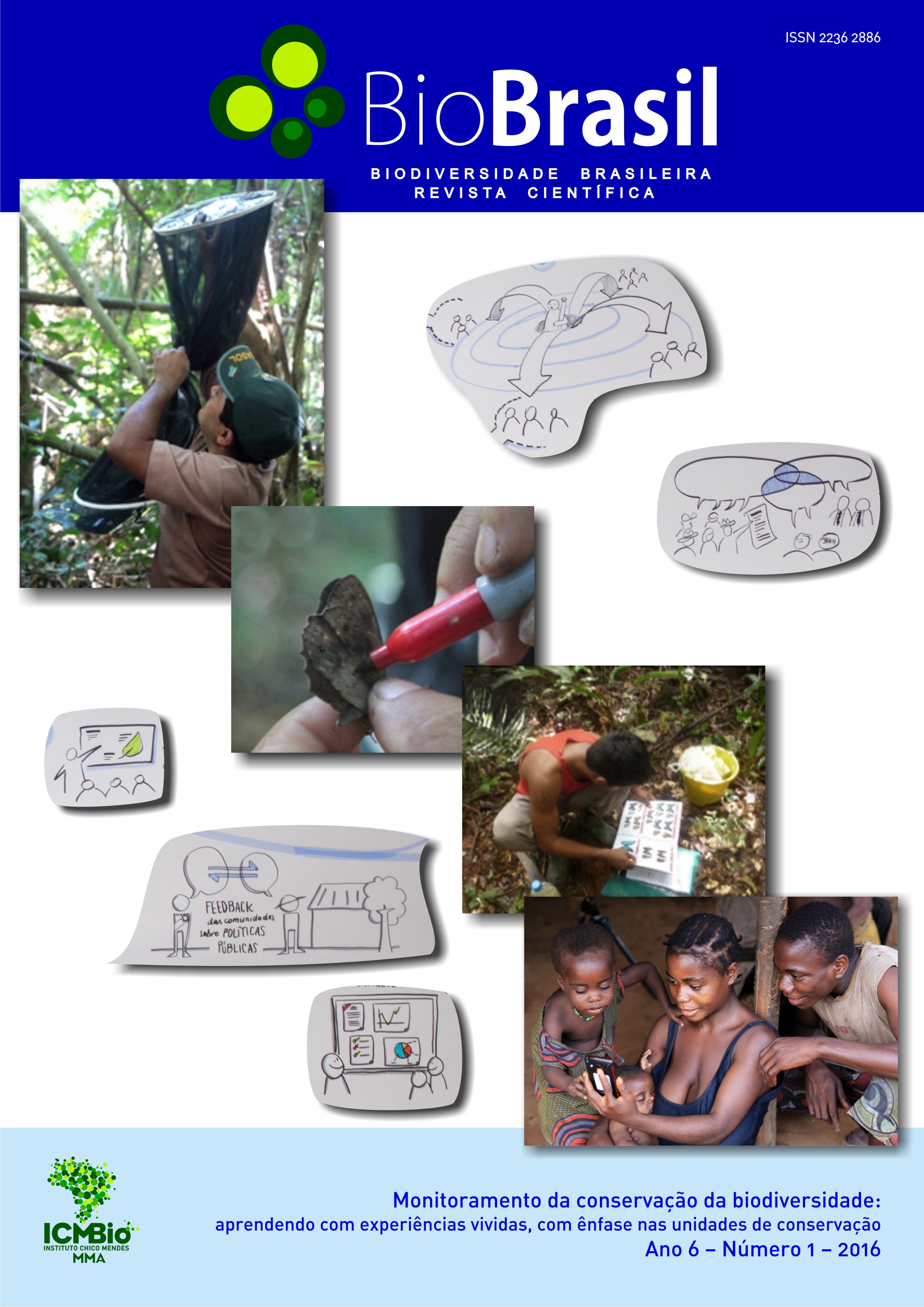Os Caminhos da conservação da biodiversidade brasileira frente aos impactos da infraestrutura viária
DOI:
https://doi.org/10.37002/biodiversidadebrasileira.v6i1.530Keywords:
impact mitigation, highways, Road ecology, Urubu System, BrazilAbstract
Highways, roads and railways where we transport our loading and people are fundamental to
social and economic development of the country. However, each kilometer of road adds a multitude of direct and indirect environmental impacts at the local and regional biodiversity. The most visible of these impacts is the wildlife-vehicle-collision (wvc), which in Brazil affects more than 475 million vertebrates every year, or 15 animals at every second. The economic growth of the country requires in creasing of the road network over 1.7 million kilometers, generating chronic impacts throughout the territory and with unpredictable consequences for biodiversity. In many protected areas the wvc exist and fragmentation, species avoidance, barrier effects as well, that preventor reduce species to access resources or new areas. Understanding the effect of wvc on protected areas requires reliable data collection that support decision-making on mitigation measures in order to prioritize actions. Much information has been lost due to the lack of data systematization, and they are, in many cases, kept in protected areas. We propose that protected areas adopt a single protocol for the collection and storage of wvc data, using systematic and/or non-systematic surveys as they prefer.Â
References
Ament, R.; Clevenger, A.P.; Yu, O. & Hardy, A. 2008. An assessment of road impacts on wildlife populations in U.S. National Parks. Environmental Management, 42(3): 480-496.
Andrews, A. 1990. Fragmentation of habitat by roads and utility corridors: a review. Australian Journal of Zoology, 26: 130-41.
Aresco, M. J. 2005. Mitigation measures to reduce highway mortality of turtles and other herpetofauna at a North Florida Lake. Journal of Wildlife Management, 69(2): 549-560.
Bagatini, T. 2006. Evolução dos índices de atropelamento de vertebrados silvestres nas rodovias do entorno da Estação Ecológica Águas Emendadas, DF/Brasil e eficácia de medidas mitigadoras. Dissertação (Mestrado). Universidade de Brasília. 78p.
Bager, A. & Fontoura, V. 2013. Evaluation of the effectiveness of a wildlife road kill mitigation system in wetland habitat. Ecological Engineering, 53: 31-38.
Bager, A. & Grilo, C. 2013. Road Ecology. Oecologia Australis, 17(1): 4-5.
Bager, A. & Rosa, C.A. 2011. Influence of sampling effort on the estimated richness of road-killed vertebrate wildlife. Environmental Management, 47(5): 851-858.
Bager, A.; Piedras, S.R.N.; Pereira, T.S.M. & Hobus, Q. 2007. Fauna selvagem e atropelamento - diagnóstico do conhecimento científico brasileiro, p. 4962. In: A. Bager (Ed.). Áreas protegidas. Repensando as escalas de atuação. Armazém Digital.
Bernardino, F.S. & Dalrymple, G.H. 1992. Seasonal activity and road mortality of the snakes of the Pa-hayokee wetlands of Everglades National Park, USA. Biological Conservation, 62:71-75.
Brasil, 2000. Lei nº 9.985, de 18 de julho de 2000. Regulamenta o art. 225, § 1º, incisos I, II, III e VII da Constituição Federal, institui o Sistema Nacional de Unidades de Conservação da Natureza - SNUC e dá outras providências.
CBEE (Centro Brasileiro de Estudos em Ecologia de Estradas). Portal do CBEE. . (Acesso em 20/01/2015).
Clevenger, A.P.; Chruszczc, B. & Gunson, K.E. 2003.Spatial patterns and factors influencing small vertebrate fauna road-kill aggregations. Biological Conservation, 109(1): 15-26. CNT. 2010. Confederação Nacional do Transporte. Revista CNT, 181.82: 73-76.
Coffin, A.W. 2007. From roadkill to road ecology: A review of the ecological effects of roads. Journal of Transport Geography, 15(5): 396-406.
Cosentino, B.J.; Marsh, D.M.; Jones, K.S.; Apodaca, J.J.; Bates, C. & Beach, J. 2014. Citizen science reveals widespread negative effects of roads on amphibian distributions. Biological Conservation, 180: 31-38.
Dodd, K.C., Jr.; Barichivich, W.J. & Smith, L.L. 2004. Effectiveness of a barrier wall and culverts in reducing wildlife mortality on a heavily traveled highway in Florida. Biological Conservation, 118(5): 619-631.
Dornas, R.A.P.; Kindel, A.; Freitas, S.R. & Bager, A. 2012. Avaliação da mortalidade de vertebrados em rodovias no Brasil. p. 139-152. In: Bager, A. (Ed.). Ecologia de estradas. Editora da UFLA.
Duke, D.L.; Hebblewhite, M.; Paquet, P.C.; Callaghan, C. & Percy, M. 2001. Restoring a large carnivore corridor in Banff National Park, p. 261-276. In: Large mammal restoration. Island Press.
Erritzoe, J.; Mazgajski, T.D. & Rejt, L. 2003. Bird casualties on European roads - a review. Acta Ornithol., 38(2):7793.
Fahrig, L. & Rytwinski, T. 2009. Effects of roads on animal abundance: an empirical review and synthesis. Ecology and Society, 14(1): 21.
Fahrig, L.; Pedlar, J.H.; Pope, S.E.; Taylor, P.D. & Wegner, J.F. 1995. Effect of road traffic on amphibian density. Biological Conservation, 73(3): 177-182.
Forman, R.T. & Alexander, L.E. 1998. Roads and their major ecological effects. Annual Review of Ecology and Systematics, 29:207-231.
Forman, R.T. & Deblinger, R.D. 2000. The ecological road-effect zone of a Massachusetts (U.S.A.) Suburban Highway. Conservation Biology, 14(1): 36-46.
Garriga, N.; Santos, X.; Montori, A. & Richter-Boix, A. 2012. Are protected areas truly protected? The impact of road traffic on vertebrate fauna. Biodiversity and Conservation, 21(11): 2761-2774.
Godbout, G. & Ouellet, J. 2008. Habitat selection of American marten in a logged landscape at the southern fringe of the boreal forest. Ecoscience, 15(3): 332-342.
Gonsamo, A. & D'Odorico, 2014. Citizen science: best practices to remove observer bias in trend analysis. International Journal of Biometeorology, 58(10): 2159-2163.
Hayward, M.W.; Hayward, G.J. & Kerley, G. I. H. 2010. The impact of upgrading roads on the conservation of the threatened flightless dung beetle, Circellumbacchus (F.) (Coleoptera: Scarabaeidae). Coleopterists Bulletin, 64(1): 75-80.
Jaarsma, C.F.; van Langevelde, F. & Botma, H. 2006. Flattened fauna and mitigation: Traffic victims related to road, traffic, vehicle, and species characteristics. Transportation Research Part D-Transport and Environment, 11(4): 264-276.
Jaeger, J.A.G.; Bowman, J.; Brennan, J.; Fahrig, L.; Bert, D. & Bouchard, J. 2005. Predicting when animal populations are at risk from roads: an interactive model of road avoidance behavior. Ecological Modelling, 185(2-4): 329-348.
Jaeger, J.A. 2015. Improving environmental impact assessment and road planning at the landscape scale. In: Handbook of road ecology. pp. 32-42. Van der Ree, R.; Smith, D.J. & Grilo, C. (eds). Wiley Blackwell. 522 p.
Kline, N.C. & Swann, D.E. 1998. Quantifying wildlife road mortality in Saguaro National Park, 23-31. In: Evink, G.; Garrett P.; Zeigler D. & Berry J. (eds). Proceedings of the International Conference on Wildlife Ecology and Transportation.
Lewinsohn, T.M. & Prado, P.I. 2005. Quantas espécies há no Brasil? Megadiversidade, 1(1): 36-42.
Lima, K. 2013. Impacto de estradas em unidade de conservação do Brasil. Monografia (Graduação em Biologia). Universidade Federal de Lavras, 93p.
Maia, A.C. & Bager, A. 2013. Projeto Malha: manual para equipe de campo. Centro Brasileiro de Estudos em Ecologia de Estradas - UFLA. 30p.
Meneguetti, D.U.O.; Meneguetti, N.F.S.P. & Trevisan, O. 2010. Georreferenciamento e reavaliação da mortalidade por atropelamento de animais silvestres na linha 200 entre os municípios de Ouro Preto do Oeste e Vale do Paraíso - RO. Revista Científica da Faculdade de Educação e Meio Ambiente, 1(1):58-64.
Meunier, G. & Lavoie, C. 2012. Roads as corridors for invasive plant species: new evidence from smooth bedstraw (Galiummollugo). Invasive Plant Science and Management, 5(1):92-100.
Miller, J.R.; Joyce, L.A.; Knight, R.L. & King, R.M. 1996. Forest roads and landscape structure in the southern Rocky Mountains. Landscape Ecology, 11: 115-27.
Moreira, A. 2011. Frota de veículos cresce 119% em dez anos no Brasil aponta Denatran. . Acessado em 15 de dezembro de 2015.
Olson, D.D.; Bissonette, J.A.; Cramer, P.C.; Green, A.D.; Davis, S.T.; Jackson, P.J. & Coster, D.C. 2014. Monitoring wildlife-vehicle collisions in the information age: how smartphones can improve data collection. Plos One: 9(6): 1-9.
Paul, K.; Quinn, M.S.; Huijser, M.P.; Graham, J. & Broberg, L. 2014. An evaluation of a citizen science data collection program for recording wildlife observations along a highway. Journal of Environmental Management, 139: 180-187.
Perz, S.G.; Warren, J.W.; David P. & Kennedy, D.P. 2008. Contributions of racial-ethnic reclassification and demographic processes to indigenous population resurgence: the case of Brazil. Latin American Research Review, 42(3): 7-33.
Reed, R.A.; Johnson-Barnard, J. & Baker, W.L. 1996. Contribution of roads to forest fragmentation in the Rocky Mountains. Conservation Biology, 10:1098-106.
Riley, S.J. 1984. Effect of clearing and roading operations on the permeability of forest soils, Karuah catchment, New South Wales, Australia. Forest Ecology and Management, 9: 238-293.
Riverson, J.; Gaviria, J. & Thriscutt, S. 1991. Rural roads in sub-Saharan Africa: lessons from World Bank experience. Technical paper, v.141. The World Bank, Washington, D.C.
Roedenbeck, I.A.; Fahrig, L.; Findlay, C.S.; Houlahan, J.E.; Jaeger, J.A.G. & Klar, N. 2007. The Rauischholzhausen agenda for road ecology. Ecology and Society, 12(1): 11.
Rosa, C.A. & Bager, A. 2013. Review of the factors underlying the mechanisms and effects of roads on vertebrates. Oecologia Australis, 17(1): 6-19.
Rosen, P.C. & Lowe, C.H. 1994. Highway mortality of snakes in the Sonoran desert of southern Arizona. Biological Conservation, 68: 143-148.
Sandoval, M.A.L. 2014. Breve histórico sobre a evolução do planejamento nacional de transportes. Dnit/Ministério dos Transportes.
Santos, S.M.; Carvalho, F. & Mira, A. 2011. How long do the dead survive on the road? Carcass persistence probability and implications for road-kill monitoring surveys. Plos One, 6(9): e25383.
Seiler, A. 2001. Ecological effects of roads: a review. Introductory Research Essay, 9:1-40
van der Ree, R.; Jaeger, J.A.G.; van der Grift, E.A. & Clevenger, A.P. 2011. Effects of roads and traffic on wildlife populations and landscape function: Road ecology is moving toward larger scales. Ecology and Society, 16(1):48.
Waller, J.S. & Servheen, C. 2005. Effects of transportation infrastructure on grizzly bears in Northwestern Montana. The Journal of Wildlife Management, 69(3): 985-1000.
Weger, L.A.; Hiemstra, P.S.; Op den Buysch, E. & van Vliet, A.J.H. 2014. Spatiotemporal monitoring of allergic rhinitis symptoms in The Netherlands using citizen science. Allergy, 69(8): 1085-1091.
Wine, S.; Gagne, S.A. & Meentemeyer, R.K. 2015. Understanding human-coyote encounters in urban ecosystems using citizen science data: what do socioeconomics tell us? Environmental Management, 55(1): 159-170.
Wittmeyer, G.; Elsen, P.; Bean, W.T.; Coleman, A.; Burton, O. & Brashares, J.S. 2008. Accelerated human population growth at protected area edges. Science, 321: 123-126.
Yost, A.C. & Wright, R.G. 2001. Moose, caribou, and grizzly bear distribution in relation to road traffic in Denali National Park
Downloads
Published
Issue
Section
License
Copyright (c) 2016 Os autores mantêm os direitos autorais de seus artigos sem restrições, concedendo ao editor direitos de ção não exclusivos.

This work is licensed under a Creative Commons Attribution-NonCommercial-NoDerivatives 4.0 International License.
Os artigos estão licenciados sob uma licença Creative Commons Atribuição-NãoComercial-SemDerivações 4.0 Internacional (CC BY-NC-ND 4.0). O acesso é livre e gratuito para download e leitura, ou seja, é permitido copiar e redistribuir o material em qualquer mídia ou formato.











